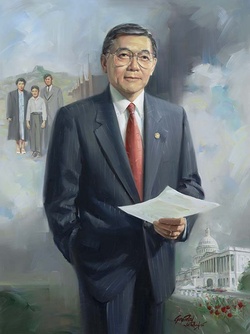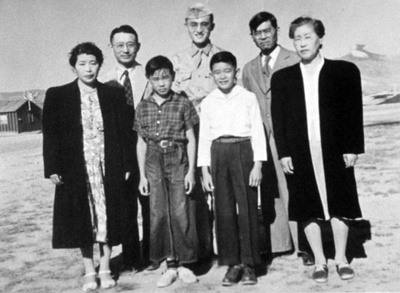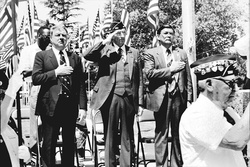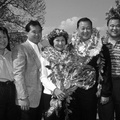When Norman Yoshio Mineta looks back on his life, he shakes his head and wonders how a little kid from San Jose wound up in Washington, D.C., first as a Congressman and then as a member of two Presidents’ Cabinets. Moreover, he has distinguished himself as an advocate for civil liberties and against racial profiling to the point that two Japanese television companies have made documentaries about him recently. “I know I’m very fortunate to have gone to places and done things and I can only thank those who gave me encouragement,” he says, humbly.

Norman Y. Mineta, oil on canvas, George and Jim Pollard, 1995. Collection of the U.S. House of Representatives.
Certainly, 11-year-old Norm Mineta, imprisoned in a concentration camp at Heart Mountain, Wyoming, in 1942, could not have conceived that he would become the first Japanese American mayor of a major mainland city. Or that his friends and neighbors in San Jose would send him to Congress in 1975, where he would serve for 20 years. How could anyone have dreamt that young Norm would one day become Secretary of Commerce AND Secretary of Transportation after once being considered, along with thousands of Japanese Americans, a security risk to the country?
Perhaps, the most poignant accomplishment of Norm’s congressional career is his crucial role in enabling the passage of the Civil Liberties Act of 1988 that provided an official apology and reparations to thousands of Japanese Americans who had their rights violated by their own government. When that bill was signed into law by President Ronald Reagan on August 10, 1988, Representative Norman Mineta stated, “Americans of Japanese ancestry now know in their hearts that the letter and spirit of our Constitution holds true for them.”
The distance that Japanese Americans traveled from being considered “enemy aliens” and “non-aliens” to full citizens is similar to the distance that Norman Mineta has traveled from his imprisonment in Heart Mountain to being awarded the Presidential Medal of Freedom in 2006. For that reason and more, the Japanese American National Museum is proud to present its Distinguished Medal of Honor for Lifetime Achievement and Public Service to the Honorable Norman Y. Mineta at its 2012 Gala Dinner.
Born to Kunisaku and Kane Mineta, Norm was the youngest of five children. His father made the trip from Japan to America as a young teenager in 1902, seeking to join up with a relative.
Unfamiliar with the geography of the United States, young Kunisaku mistakenly thought he could walk from Seattle to San Jose in a short period. “It took him almost two years to work his way down the coast to meet his uncle,” Norm explained. His uncle insisted he learn English and 16-year-old Kunisaku enrolled in first grade. His ability to speak English got him work as a court interpreter and he even wrote for the Nichi Bei Times. Kane arrived as a picture bride in 1912 and they started their family. Kunisaku established an insurance agency and the family prospered enough that Norm’s three sisters, Aya, Etsu and Helen, and brother Albert were all able to enroll in college.
WORLD WAR II
When the Japanese attacked Pearl Harbor on December 7, 1941, and brought the United States into World War II, the consequences to Japanese Americans families like the Minetas were severe. Norm recalled the neighbors frantically reporting their Issei father being taken away that day. When President Roosevelt signed Executive Order 9066 on February 19, 1942, all persons of Japanese ancestry were suspect in the government’s eyes and thousands were forced to leave their homes and businesses for an unknown future. Kunisaku had to close his insurance agency and his bank account was frozen with the funds never returned.
Loaded onto a train, Norm famously dressed in his Cub Scout uniform and carried his baseball glove and bat. The military police confiscated his bat, causing the 10-year-old to run crying to his father. But as the train was leaving, Norm saw something rare. “I’ve only seen my dad cry three times,” he recalled. “Once on December 7th because he couldn’t understand why the land of his birth was now attacking the land of his heart. The second time was when we were leaving San Jose, not knowing if we would ever see it again.” The last time, years later, was when Norm’s mother passed away.
The government’s treatment of Japanese Americans during World War II would bring many strong individuals to tears. The Minetas were first taken to the Santa Anita racetrack in Arcadia to live in and around the horse stalls. They were then transferred in November to Heart Mountain, Wyoming, where the first winter saw temperatures drop to 30 degree below zero. "We were greeted by a blinding sandstorm when we arrived. I remember the sand whipping up into the barracks through the cracks in the floorboards," Norm recalled. "It was cold, bitterly cold, and since we were all from California, most people had to make do with light jackets and blankets.”
His memories of camp would stay with young Norm for the rest of his life. One lasting good that came from his Wyoming experience was meeting fellow Boy Scout Alan Simpson, who would become a member of the Senate and Norm’s lifelong friend. By 1943, his father was able to get a job teaching Japanese to U.S. soldiers in Chicago. Norm and his mother soon followed.

Norman Mineta (white shirt, front) and his parents Kunisaku and Kane (right) were forced by the government to live in the Heart Mountain, Wyoming concentration camp during World War II. Photo courtesy of NHK/Norman Mineta
The Minetas were able to return to San Jose and their old house because it had been rented to a professor at San Jose State. Norm’s father restarted his insurance agency and Norm graduated from San Jose High School. He enrolled in the University of California at Berkeley, thinking he might become an engineer and design airplanes. “That was until I had to take calculus,” Norm recalled. Instead, he graduated with a business degree. A member of the school’s ROTC program, he joined the Army and was assigned to the intelligence section in Japan. When he finished his tour, he returned to San Jose and joined the family business.
PUBLIC SERVICE

Norman Mineta with veterans Gift of Norman Y. Mineta, Japanese American National Museum (96.370.24D)
A life in public service for Norman Mineta was encouraged by his father and other Issei leaders like Kozo Ishimatsu, a lettuce grower. Mr. Ishimatsu believed that a major reason Japanese Americans were forced from their homes was their lack of access to public officials. Money was scarce, but Mr. Ishimatsu would gather small donations from the community and then send young people, like Norm, to both Democratic and Republican events. Norm’s civic involvement led to his appointment to the San Jose Human Relations Commission and later to the San Jose City Council. He won election as mayor, the first Asian American to hold such a position.
Prepared to stand for re-election in 1974, Norm was urged by colleagues to run for the vacant congressional seat. He became the first Democrat to win election in 48 years and was a member of Congress for over 20 years. “I always felt strong about accessibility and accountability,” he explained. “And I think again it goes back to my own experience in terms of the evacuation and internment. We didn’t have access to our political leaders at the time.” Norm would be that accessible leader.
Rep. Mineta served as chairman of the House Public Works and Transportation Committee between 1992 and 1994. He chaired the Committee's Aviation Subcommittee between 1981 and 1988, and chaired its Surface Transportation Subcommittee from 1989 to 1991. Among his key legislative accomplishments were the Americans with Disabilities Act of 1991 and the Intermodal Transportation Efficiency Act of 1991. He also co-founded the Congressional Asian Pacific American Caucus.

In 1974 Norman Mineta was elected to Congress and served for over 20 years. He worked with President Carter (left) and his colleagues Patsy Mink and Robert Matsui (right). Japanese American National Museum, (96.370.14C / 96.370.23F)
*This article was originally published in the Japanese American National Museum's 2012 Dinner Journal, Transforming a Forgotten Story.
© 2012 Japanese American National Museum






